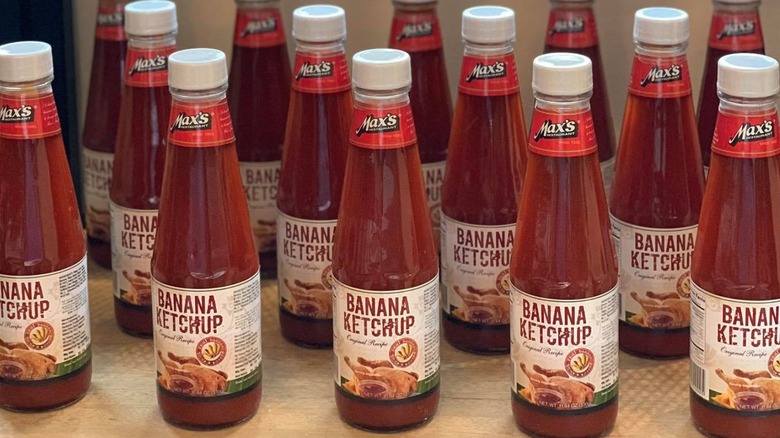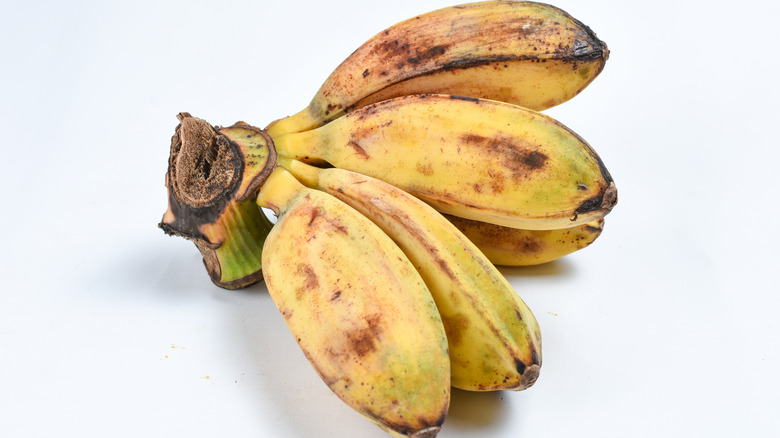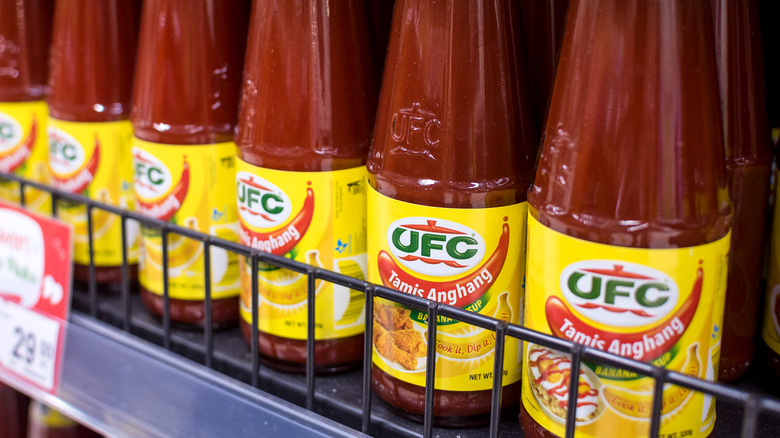Why Banana Ketchup Could Be Your New Favorite Condiment
While bananas are a fruit we're more accustomed to enjoying as part of a bread, cake, or muffin than as a condiment, there are parts of the world where certain indigenous bananas are mashed, processed, and turned into a flavorful dipping sauce for fried chicken. We're talking about the Philippines, where a local variety of banana was turned into a ketchup alternative nearly a century ago, per Esquire.
Banana ketchup is a much-loved supporting actor in restaurants and homes where authentic Filipino food can be found. It imparts a distinctive flavor that is sweet and vinegary, carrying few tomato undertones while also being very non-banana-like. Some might compare it to a Thai sweet chili sauce. It delivers on visual impact, too, because commercial banana ketchup comes tarted up in a bright, red orange hue that those who grew up with iconic Filipino fast food chains like Jollibee or Max's Restaurant, per Seattle Times, will know all too well. Banana ketchup is enjoyed with just about everything, from fried chicken and burgers to the ubiquitous Filipino sweet spaghetti, which Food52 says is made with a base of banana ketchup instead of the traditional Italian tomato sauce.
Banana ketchup was invented with indigenous Filipino bananas
Credit for the discovery of the type of banana known as saba or sweet plantain, per Specialty Produce, goes to a food scientist named Maria Ylagan Orosa. She grew up in the Philippines but went to the University of Washington in 1916, where she picked up degrees in pharmaceutical chemistry and food chemistry, per Lady Science. Orosa appeared to learn in the field as much as she did in the classroom; during some breaks, she worked at a salmon canneries to understand industrial preservation and packaging, and while she was at school, she worked in the dean of the Pharmacy School's food laboratory as an assistant chemist.
Orosa eventually returned to the Philippines and joined the country's Bureau of Science, where her primary interest was in malnutrition and food security. This led to her to work on different ways of preserving foods to survive the country's tropical environment, including canning, dehydrating, fermenting, and freezing. It was her desire to spotlight indigenous ingredients — as well as a local tomato and ketchup shortage due to World War II's complication of imports — that led her to the discovery of banana ketchup.
Its flavor is sweet and complex
To make the now ubiquitous ingredient, Orosa blended saba bananas, brown sugar, vinegar, and spices, per Esquire. Because the sauce didn't look particularly enticing, it was decided that red food coloring should be added to make the condiment appear, at least visually, closer to its ketchup counterpart made with tomatoes. Orosa was eventually killed during the Battle of Manila in 1945, leaving behind over 700 recipes, which Lady Science describes as the "pillars of Filipino cuisine" today. But what of the ketchup? A commercial version was said to have been created by one Magdalo V. Francisco, who made it the commercial success it is today.
Banana ketchup, as Serious Eats envisions it, is perhaps more complex in ingredients than Orosa or Francisco would have come up with nearly a century ago. This cousin of the Filipino everyman condiment is made with onions, garlic, jalapeno, and a spice combination of ginger, turmeric, and allspice, as well as bananas, vinegar, tomato paste, soy sauce, and rum. The recipe is adapted from one developed by Ray Lampe, who is also known as Dr. BBQ, and we can only imagine it would work wonders with your favorite grilled meats.


